|
The Hereward
Lodge
of
Freemasons
Inaugurated
1868 |
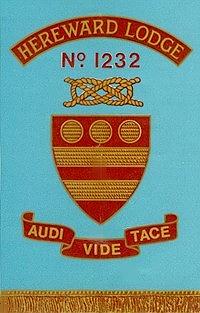 |
Freemasonry is a movement whose
members are joined together in a fraternal association based on brotherly
love, faith and charity. It is non-political, open to men of any religion
and is known for its rituals and signs of recognition that have been
copied from antiquity and to the practices of the mediaeval Roman Catholic
craft guild of stonemasons.
During the 13th century when many large buildings were erected, masons
were itinerant workers travelling the country as their skills required
and subsequently able to recognise fellow craftsmen and exclude
interlopers. In the 17th century, the masons’ clubs or lodges began to be
attended by gentlemen who had no connection with the trade and in time
they came to outnumber the masons.
Little is known about the movement leading to the foundation of the Grand
Lodge of England in 1717 except that during this period the transformation
from craft guild to a secret society for gentlemen took place although the
terms of the stonemason’s trade were retained and his tools are included
in the rituals still practiced.
Lodges were subsequently formed throughout Britain and the craft, as it
became known, also spread to the United States, the colonies and to
European countries. There are now 330,000 masons in the United
Kingdom and the Grand Lodge runs a benevolent institution and
a school for orphans of former masons. Those who join come from all walks
of life and have included members of the royal family.
During the middle years of the 19th century, lodges sprang up at Spalding
and Grantham and those from Bourne who wished to join had to travel
there to attend but eventually decided to form a lodge of their own. Hereward
the Wake, having a traditional connection with the town, seemed an
appropriate dedication and it came into being on Monday 9th November 1868.
The first entry in the lodge minute book, in beautiful copperplate
handwriting, tells of the inaugural meeting at the Angel Hotel at "4½
oc pm" to
constitute and consecrate a new lodge under the name of the Hereward Lodge
No 1232, each lodge being given a number in order of its consecration, the
first lodge, No 1, being that formed in 1717.
It had been hoped that the consecration might be performed by the
Provincial Grand Master for Lincolnshire, the Duke of St. Albans, because
he had a house at Redbourne, near Brigg, North Lincolnshire, but he rarely
stayed there and was not available and so the ceremony was conducted by
the Deputy Grand Master, Worshipful Brother W H Smythe. There were 29
visitors in addition to the consecration team, who came mainly from the
Hundred of Elloe Lodge No 469 at Spalding. The first master of the lodge
also came from Spalding and is listed as the Reverend Edward Evans Hadath.
The Stamford
Mercury reported the following Friday: "The newly created lodge bids
fair to take a respectable position amongst the various lodges of the
parish. After the ceremonial was conducted, Mr Henry Bott, mine host at
the Angel Hotel, supplied a sumptuous banquet which was partaken by 40 of
the brethren."
No time was wasted in admitting new members from the town and in December
of the same year, the Angel landlord Henry Bott joined together with Thomas Withers,
ironmonger, William Webber, headmaster of the Old Grammar School, William
Hall, a cabinet maker, of South Street, and Shadrack Frost, professor of
music. William Hall also employed his skills for the benefit
of the lodge by making some of the furniture that is still in use today.
The lodge therefore got off to a good start but there was considerable
turmoil ahead. Thomas Withers resigned in March the following year, making
his membership perhaps the shortest Masonic career on record, and there
was some controversy over the admission of new members while others
were in arrears with their dues. Fortunately, most problems were solved
and this ensured a period of stability with many new members joining,
among them John Smith, a grocer of Bourne, aged 41, who was initiated in
1873.
There were further problems two years later when a clergyman, the Reverend
Daniel Ace, became a member and was very quickly installed as master but
after serving the customary year in office, he refused to stand down but
was ordered to do so by the Grand Lodge of England and he subsequently
left the area and moved to London where he was made master of a lodge
immediately although it is not known whether he was allowed to continue in
office longer than the customary one year.
From this time, the lodge seemed to enjoy a much more harmonious
existence. The meetings were held in the long room at the Angel Hotel that
was rented for six shillings a year. In 1882, it was decided to change the
date of meetings to the Friday on or before each full moon and even today,
the lodge still meets on the third Friday of every month from September to
May inclusive.
In 1883, the first member of the Wherry family, Robert Leonard Wherry, a
draper, joined followed in 1889 by Thomas William Mays, a wool stapler
and father of the motor racing pioneer, Raymond Mays. In 1889, the Prince of Wales, who was then the Grand Master of
England, visited Grimsthorpe Castle, near Bourne, and the lodge held a
reception when he was presented with an illuminated address, a grand royal
occasion much enjoyed by the members.
In 1889, the lodge accepted William Robert Leary, aged 32, a hairdresser,
into its ranks and he is remembered today for his later work as organist and choirmaster at the
Abbey Church. There followed several more new members who were prominent
citizens, Joseph Ellicock, a watch and clock maker, of South Street, Joseph Davies, headmaster of the board
school in Abbey Road, Thomas Lake, surveyor, of West Road, Alfred Stubley,
scenic artist, of West Street, and Herbert Tointon, bank manager.
An interesting note in the minutes of 1907 says it was agreed to a review
of the rental for meetings at the Angel Hotel and to pay £6 per annum, but
the increase stipulated that the landlady, Mrs Annie Townson, give an
undertaking that “the nuisance of her piano playing during lodge hours be
discontinued”.
The minutes of 24th May 1912 also contain a tragic reminder of
the British passenger liner Titanic, which sank off Newfoundland after
striking an iceberg with the loss of more than 1,500 lives, because an
entry records that the lodge agreed to send one guinea to the distress
fund being raised for the survivors.
Roy Few Carvath, a dentist, and Charles Pask Matthews, headmaster of Bourne
Grammar School, both joined the lodge at this time and John William
Hinson, known affectionately in the town as Nipper, served the Lodge
faithfully for 34 years.
In 1923, the minutes record the rejection of an offer by the church
council for the sale of the Vestry Hall as a suitable meeting room
although from 1925 onwards the premises were used on special occasions for
several years, particularly for the annual installation of the Master of
the Lodge after special dispensation had been given each time by the
Provincial Grand Lodge.
Edgar Judge, a chemist, of North Street, became a member in 1925 and was a
stalwart for many years, occupying several offices. Similarly, Leslie
Robert William Day (affectionately known as LRW), a schoolmaster and later
headmaster of the former Bourne County Secondary School. S C Appleton, a
master at Bourne Grammar School, joined in 1931 and served as secretary
for 30 years, being particularly remembered for his work in keeping the
lodge active during the Second Wold War years of 1939-45 when many members
were away serving in the forces.
The Angel Hotel had been a convenient and convivial place for meetings
over a period of 70 years but there was a hankering among members to own
their own premises and in November 1933, a letter was received from the
London Central Meat Company offering a golden opportunity. The company
wanted to dispose of a plot in Wherry’s Lane, off North Street, and it
seemed a most appropriate place for a purpose built lodge, covering 330
square yards and with a frontage of 66 feet on the public road. The asking
price was £33 with the proviso that a new dividing wall of the same height
and thickness as the other boundary wall was constructed or it could form
part of the new building to be erected. The purchase was agreed and a
building committee set up to oversee the project.
It was estimated that the total cost would
be £1,500 and the long awaited
moment arrived on 31st August 1938 when the new premises were consecrated
by the Provincial Grand Master for Lincolnshire, Lord Heneage. A total of
100 freemasons crowded the new building to witness the realisation of a
long cherished ambition. The first meeting held there was the occasion of
Edwin Nathaniel Moody, nurseryman, becoming a member together with Raymond
Leonard Ringrose who became the longest serving member with over 70 years
of service.
The use of the lodge building was largely lost during the Second World War. At an
emergency meeting on 11th October 1940, it was announced that the ground
floor would be requisitioned by the army to provide accommodation for
troops stationed in the Bourne area and it was subsequently used as an
officers’ mess until the end of the conflict.
Meetings were soon back to schedule and local solicitor Horace Stanton was
appointed treasurer in 1945, an office which he occupied until 1967 and in
1956, John Hinson retired from office as Tyler [a lodge appointment] to be
succeeded by Ernest Robinson who went on to complete almost 40 years of
loyal service. Many other well known names from the town can be seen on
the honours boards that hang in the lodge, Reid Carlton, Jack Burchnell, George Knipe,
Jim Mayfield, Dr John Galletly, Edward Stringer,
Dr George Holloway, Thomas Rickard and Frederick North, all of whom have sadly
passed on.
On Saturday 9th November 1968, the lodge celebrated its centenary meeting
with a packed attendance in excess of 150. Freemasonry continued to
prosper in the town and numbers increased to such an extent that it was
decided to open a daughter lodge to be known as the Lodge of Aveland and it
was consecrated in 1982 as Number 9060 with meetings on Wednesday evenings.
Much of the secrecy that was perceived to surround freemasonry in past
years has now gone although lodge meetings remain private occasions open
only to members. However, freemasons are now encouraged to speak openly
about their membership and a policy of openness is practiced by all
lodges, most of them holding periodic open days to enable the public see
their premises, inspect the regalia and talk to members about their work.
The Hereward Lodge has played its part and over 100 visitors turned up for
their last open day in 2004.
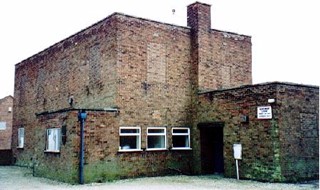
Unfortunately, the lodge building in
Wherry’s Lane became the target of repeated vandalism and graffiti and the
first floor windows facing the lane were bricked up to prevent further
expense of replacing broken glass. It was then described as the ugliest
building in the town, although this somewhat degrades its very pleasant
interior.
In September 2010, the building was sold to
South Kesteven District Council for £375,000 as part of a proposed redevelopment scheme
for Wherry's Lane which will eventually include a series of shops and flats, but
was leased back to the Hereward Lodge for the following
twelve months. "Acquisition was inevitable", said lodge secretary, Derek Bontoft, "but this was a more agreeable way of going through the process
rather than compulsory purchase. We will now be active in seeking new
premises while we lease the building."
An existing building in Roman Bank,
previously used as a snooker hall, was
eventually purchased and adapted for use as the new Masonic centre which
was opened on Monday 5th September 2011 when the Provincial Grand Master,
Graham Ives, and his team of Provincial Grand Lodge Officers joined with
the freemasons of Bourne and other visitors for the dedication ceremony
and a commemorative plaque was unveiled to mark the occasion.
Among those
present was Raymond Ringrose who, at the age of 97, was still the longest
serving member of the Hereward Lodge. He
was presented with a certificate of merit by the PGM in appreciation of
his dedicated service during which time he has held several positions of
seniority. Raymond continued as a member until he died on 4th February
2012, aged 97. He formerly lived in North Road but in 1943, he had moved
to live in Boston yet continued to make the journey back to Bourne to
attend practically every meeting.
|
THE END OF AN ERA |
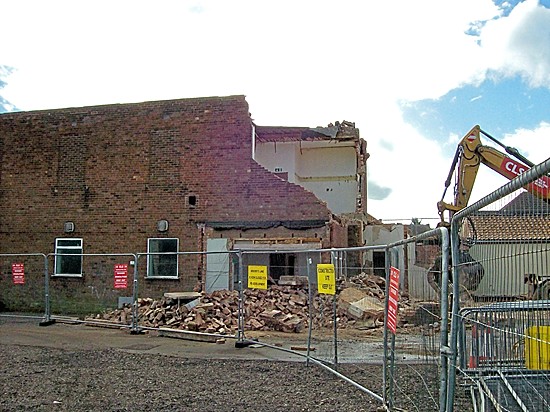 |
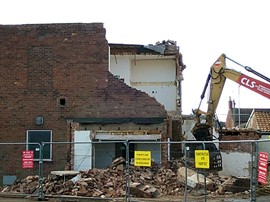 |
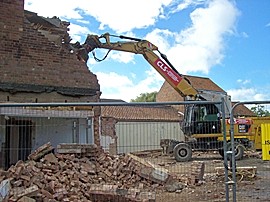 |
|
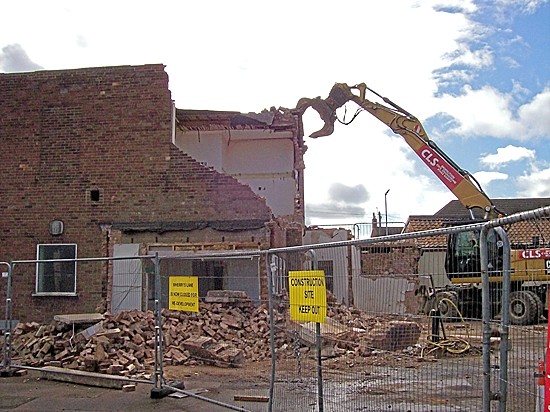 |
|
The old masonic lodge was demolished in October
2012 to make way for a redevelopment scheme in Wherry's Lane where
it is being replaced with a block of shops and flats. |
|
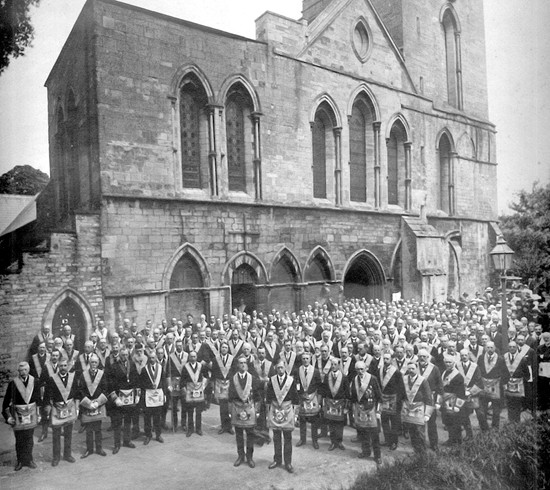 |
|
Freemasons from throughout Lincolnshire
gathered at Bourne in the summer of 1916 for the annual meeting of
all county lodges. The June celebrations included a service at the Abbey
Church and the picture above shows members wearing their full
regalia in honour of the event, a practice for open air functions
which was later banned in 1922. |
Note: I am indebted to Derek Bontoft, secretary of
the Hereward Lodge, for supplying
information from the minute book while writing this
article and for
permission to take photographs of the lodge interior.
REVISED FEBRUARY 2012
See also
Inside the old lodge
Inside the new Masonic centre

Go to:
Main Index Villages
Index
|






